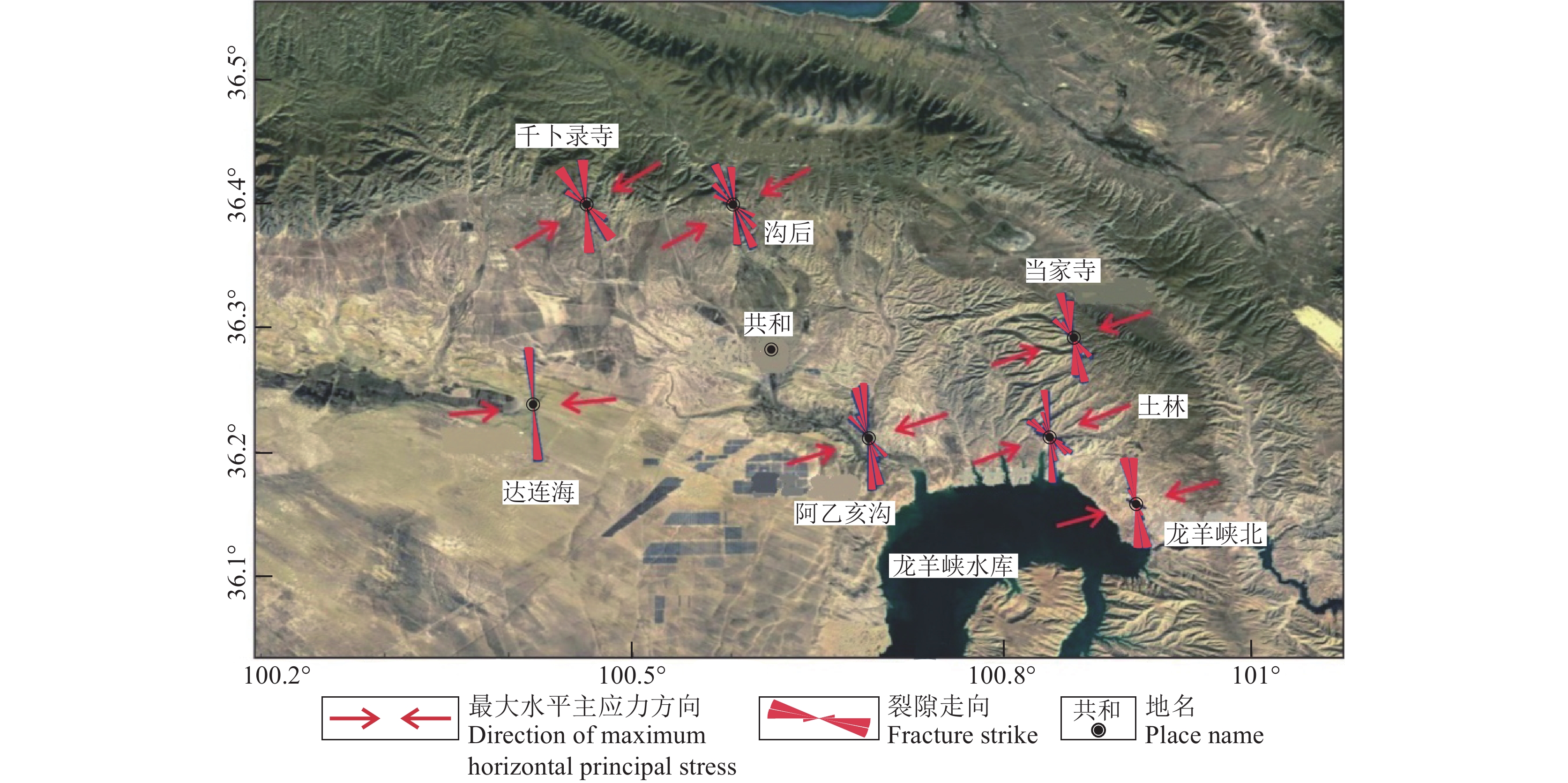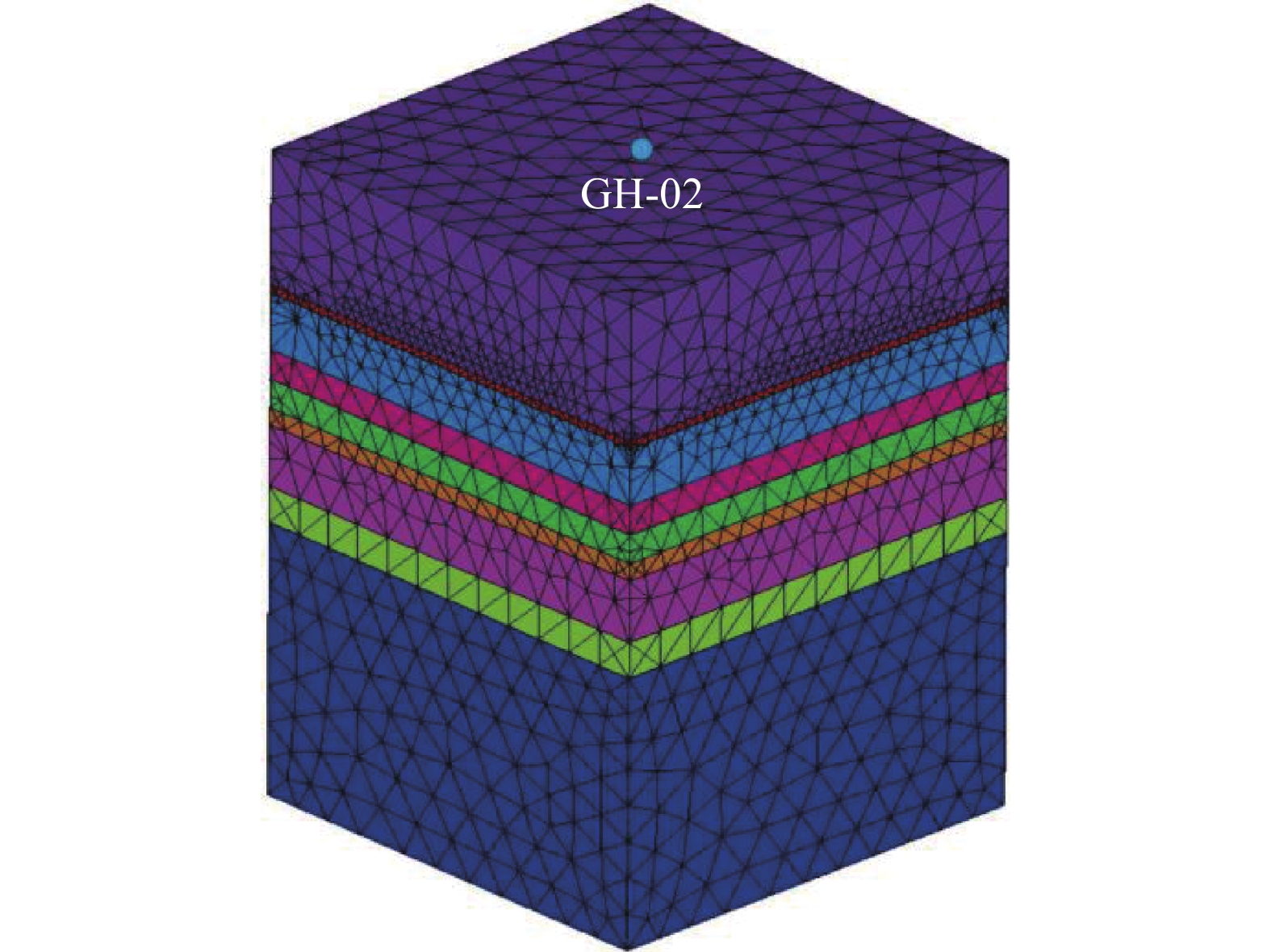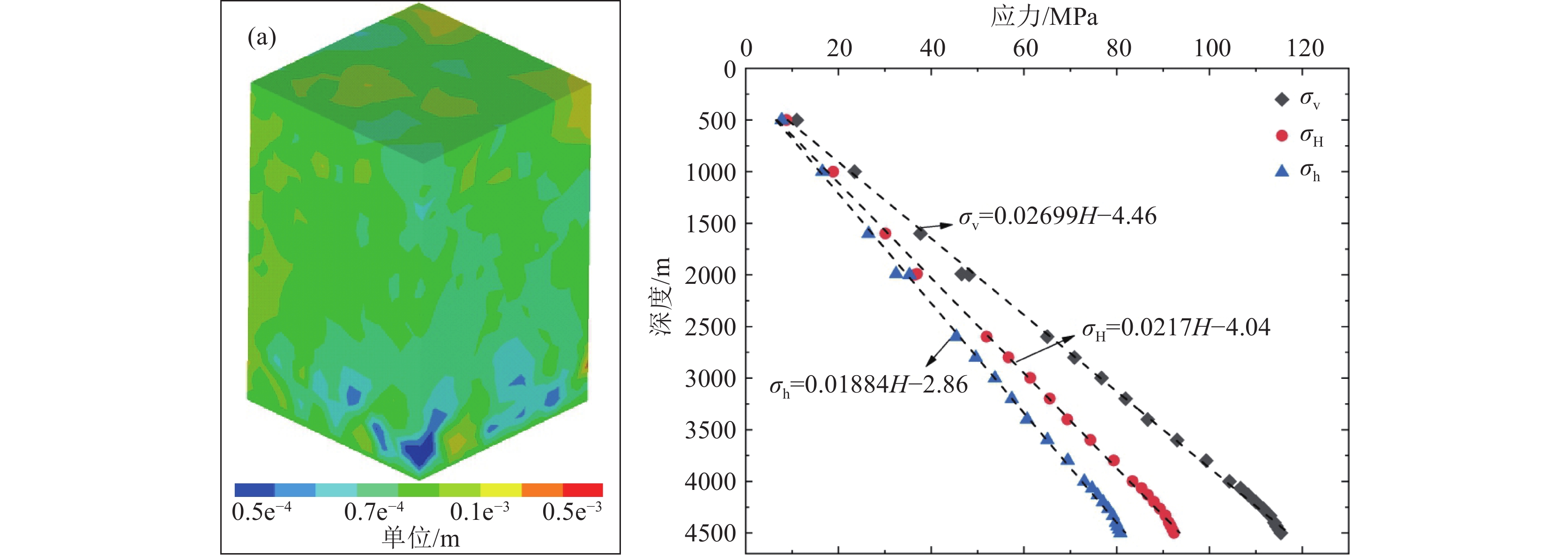In−situ stress characteristics and fault stability analysis of hot dry rock GR2 well in the Gonghe Basin, Qinghai
-
摘要:
研究目的 地应力大小和方向是干热岩开发中井位部署、压裂设计和储层评价等方面的重要基础数据,研究储层应力状态对干热岩开发具有重要意义。
研究方法 本文根据区域地质构造演化、震源机制解反演结果、节理裂隙统计、原地应力实测数据分析了共和盆地区域应力场的特征,结合共和GR2地热井储层构造、地层岩性特点建立三维模型,利用正交各向异性弹性本构关系,通过数值模拟获取了共和盆地GR2井的三维地应力数据,探讨了区域构造应力场及干热岩注水开发与断层稳定性。
研究结果 ①模拟所得地应力分布与理论值吻合,满足初始位移精度要求,最终预估了井中地应力场分布特征;②在500~4500 m深度范围内,三向主应力总体表现为σv> σH >σh,表明该区域应力结构有利于正断层活动;③青海共和盆地最大水平主应力方向整体上呈北东(NE)向挤压变形作用为主,有利于花岗岩岩体具有低的流体渗透率、低的热流传导。④在统一的区域地应力场作用下, 研究区3900~4500 m干热岩注水开发过程中,当地面持续注入压力达到或超过约19.9 MPa 时,可能引起场区内断层的滑动失稳,导致中小地震的发生,在干热岩开发利用中需注意防范。
结论 研究结果对共和盆地地球动力学研究及干热岩安全开发利用具有一定参考价值。
Abstract:This paper is the result of geological survey engineering.
Objective The magnitude and direction of in−situ stress are important parameters for well placement, fracturing design and reservoir evaluation in hot dry rock development. It is of great significance to study reservoir stress state for hot dry rock development.
Methods In this paper, the characteristics of current stress field in the Gonghe Basin are analyzed based on regional geological structure evolution, focal mechanism solution and inversion results, statistics of joints and fissures, and in−situ stress measured data. Combined with the reservoir structure and stratigraphic lithofacies characteristics of GR2 well, a three−dimensional model is established, and the three−dimensional in−situ stress data of GR2 well in the Gonghe Basin is obtained through numerical simulation by using orthogonal anisotropic elastic constitutive relation. The regional tectonic stress field and occurrence conditions of dry hot rock resources are discussed.
Results ① The simulated stress distribution is consistent with the theoretical value, which meets the requirements of initial displacement accuracy, and finally predicts the distribution characteristics of in−situ stress field in the well. ② In the depth range of 500~4500 m, the relationship of three principal stresses is principal stress is σv>σH >σh, indicating that the stress structure in this region is favorable to normal fault activity. ③ The maximum horizontal principal stress direction of the Gonghe Basin in Qinghai province is mainly NE direction compression deformation, which is conducive to low fluid permeability and low heat transfer of granite. ④ Under the action of a unified regional stress field, the faults may be come instability near the injecting well, when the continuous injection pressure on the ground reaches or exceeds about 19.9 MPa during the water injection development of 3900~4500 m depth in the study area, leading to the occurrence of medium and small earthquakes, which should be prevented in the development and utilization of the hot dry rock.
Conclusions The research results have certain reference value for geodynamics research and the safe development and utilization of dry hot rock in the Gonghe Basin.
-

-
图 1 共和盆地地质构造简图(据王二七等,2009修改)
Figure 1.
图 2 基于裂隙统计的共和干热岩区地应力方向投影图(据雷治红,2020修改)
Figure 2.
图 3 共和盆地干热岩区最大水平主应力方位(据王洪等,2021修改)
Figure 3.
图 4 共和盆地震源分布图(a)(据雷治红,2020修改)和震源机制综合解(b)
Figure 4.
表 1 共和干热岩分布区节理裂隙主应力方向统计
Table 1. Statistics of principal stress direction of joints and fractures in hot dry rock area of Gonghe Basin
位置 经度/° 纬度/° 最大主应力/° 岩性露头 达连海 100.41E 36.23N NE 85 临夏组泥岩 千卜禄寺 100.46E 36.39N NE 60 印支期花岗岩 沟后 100.58E 36.39N NE 62 印支期花岗岩 阿乙亥 100.68E 36.21N NE 73 共合组砂岩 龙羊峡 100.90E 36.15N NE 75 印支期花岗岩 土林 100.83E 36.21N NE 70 临夏组泥岩 党家寺 100.85E 36.29N NE 72 印支期花岗岩 表 2 干热岩GR2井岩层类别及岩层力学参数
Table 2. Rock stratum category and rock mechanics parameters of hot dry rock GR2 well
岩性 深度/m 密度/(kN/m3) 泊松比 弹性模量/GPa μx μy μz Gxy Gyz Gxz 泥岩 945 22000 0.238 0.238 0.238 7.51 7.51 7.51 砂岩 1000 23650 0.240 0.240 0.240 14.85 14.85 14.85 二长花岗岩 1395 25770 0.253 0.253 0.253 35.44 35.44 35.44 黑云母花岗岩 1600 25810 0.255 0.255 0.255 42.15 42.15 42.15 花岗闪长岩 1800 26850 0.264 0.264 0.264 43.15 43.15 43.15 二长花岗斑岩 1920 26820 0.258 0.258 0.258 46.56 46.56 46.56 黑云母花岗岩 2350 27560 0.274 0.274 0.274 40.25 40.25 40.25 二长花岗岩 2600 27860 0.269 0.269 0.269 42.36 42.36 42.36 黑云母二长花岗岩 4000 27960 0.271 0.271 0.271 41.28 41.28 41.28 表 3 干热岩地热井地应力数值模拟值对比
Table 3. Comparison of stress field numerical simulation values in geothermal wells of dry hot rock
深度/m 井名 σv/MPa 相对误差 σH/MPa 相对误差 σh/MPa 相对误差 3000 GR2 77 3.75% 61 15% 54 6.8% GR1 80 72 58 3500 GR2 92 3.15% 72 16.2% 63 7.3% GR1 95 86 68 4000 GR2 104 3.7% 83 15.3% 72 5.3% GR1 108 98 76 -
[1] Amadei B, Stephansson O. 1997. Rock Stress and Its Measurement[M]. Centek Publishers.
[2] Byerlee J. 1978. Friction of rocks[J]. Pure & Applied Geophysics, 116(4/5): 615−626.
[3] Ding Sanping. 2008. Early Palaeozoic Tectonic Framework and Evolution in the Junction of Western Qinling Orogenic Belt and Qilian Orogenic Belt[D]. Xi'an: Chang'an University, 1−200(in Chinese with English abstract).
[4] Dong Zhiping, Yao Zhengsheng, Lei Fang. 1992. Active faults and modern tectonic stress field in the region of eastern Qinghai[J]. Crustal Deformation and Earthquake, 12(4): 64−71 (in Chinese with English abstract).
[5] Du Changting. 2001. Characteristics of the mechanism solutions of Gonghe earthquakes[J]. Plateau Earthquake Research, 13(4): 1−5 (in Chinese with English abstract).
[6] Feng C J, Gao G L, Zhang S H, Sun D S, Zhu S Y, Tan C X, Ma X D. 2022. Fault slip potential induced by fluid injection in the Matouying enhanced geothermal system (EGS) field, Tangshan seismic region, North China[J]. Natural Hazards and Earth System Sciences, 22(7): 2257−2287.
[7] He Dafang, Zeng Lin, Yang Hanyuan, Ye Jianling, Cao Hui, Zhang Dali. 2018. Granite mass hot dry rock resources hosting condition in hunan[J]. Coal Geology of China, 30(2): 50−57,67 ( in Chinese with English abstract).
[8] He Jiangda, Xie Hongqiang, Wang Qizhi, Xiao mingli. 2009. Inversion analysis of initial geostress in dam site of Guandi Hydropower Project[J]. Chinese Journal of Geotechnical Engineering, 31(2): 166−171 (in Chinese with English abstract).
[9] He Manchao, Xie Heping, Peng Suping, Jiang Yaodong. 2005. Stduy on rock mechanics in deep mining engineering[J]. Chinese Journal of Rock Mechanics and Engineering, 24(16): 2804−2813 (in Chinese with English abstract).
[10] Jing Feng, Sheng Qian, Zhang Yonghui, Luo Wenchao, Liu Yuankun. 2007. Research on distribution rule of shallow crustal geostess in China mainland[J]. Chinese Journal of Rock Mechanics and Engineering, 26(10): 2056−2062 (in Chinese with English abstract).
[11] Lee K K, Ellsworth W L, Giardini D, Townend J, Ge S, Toshihiko S, Yeo I, Kang T S, Junkee R, Sheen D H, Chang C D, Woo J U, Langenbruch C. 2019. Managing injection−induced seismic risks[J]. Science, 364: 730−732. doi: 10.1126/science.aax1878
[12] Lei Zhihong. 2020. Study on the Characteristics of Hot Dry Rock Reservoir and Fracturing Test Model in the Gonghe Basin, Qinghai Province[D]. Changchun: Jilin University, 1–178 (in Chinese with English abstract).
[13] Lei Z H, Zhang Y J, Yu Z W, Hu Z J, Li L Z, Zhang S Q, Fu L, Zhou L, Xie Y Y. 2019. Exploratory research into the enhanced geothermal system power generation project: The Qiabuqia geothermal field, Northwest China[J]. Renewable Energy, 139: 52−70. doi: 10.1016/j.renene.2019.01.088
[14] Li Liangzhen, Zhang Yanjun, Lei Zhihong, Zhang Qian, Zhang Senqi, Fu Lei. 2019. Inversion analysis of 3D geostress field in GR2 well area of Gonghe hot rock geothermal well[J]. Chinese Quarterly of Mechanics, 40(1): 115−123 (in Chinese with English abstract).
[15] Liu Aihua, Yang Qing, Wu Junping. 2013. A practical ANSYS 3−D numerical simulation method for in−situ stress field[J]. Journal of Geomechanics, 19(2): 133−142 (in Chinese with English abstract).
[16] Liu Jian, Hui Chen, Fan Jianming, Lü Wenya, Wang Jiwei, Yin Chen, Wang Haonan. 2021. Distribution characteristics of the present−day in−situ stress in the Chang 6 tight sandstone reservoirs of the Yanchang Formation in the Heshui Area, Ordos Basin, China and suggestions for development[J]. Journal of Geomechanics, 27(1): 31−39 (in Chinese with English abstract).
[17] Liu Hongzhan, Zhang Xiaoling, Yao Mingbo. 2014. Geothermal geology characteristic and origin analysis of Shilin Basin in Yunnan Province[J]. Journal of East China Institute of Technology (Natural Science), (1): 69−74 ( in Chinese with English abstract).
[18] Lu Chuan, Wang Guiling. 2015. Current status and prospect of hot dry rock research[J]. Science & Technology Review, 33(19): 13−21 (in Chinese with English abstract).
[19] Michael A J. 1987. Use of focal mechanisms to determine stress: A control study[J]. Journal of Geophysical Research: Solid Earth, 92: 357−368.
[20] Ren Haidong, Wang Tao. 2017. Temporal−spatial variations, sources and tectonic significances of the Triassic granitic rocks in the Juncti on part of the east Kunlun and west Qinling Orogen, Central China[J]. Acta Geoscientica Sinica, 38(S1): 59−63 (in Chinese with English abstract).
[21] Shangguan Shuantong, Sun Dongsheng, Zhang Guobin, Yang Yuehui, Qi Xiaofei, Chen Dongfang, Qiao Yongchao, Li A Wei, Chen Qunce. 2021. In−situ stress measurement and fault stability analysis within a depth of 3−4 km in the Tangshan area[J]. Acta Geologica Sinica, 95(12): 3915−3925 (in Chinese with English abstract).
[22] Sun Dongsheng. 2014. Experimental Study of Aneiastic Strain Recovery in−Situ Stress Measurement Methods and its Application[D]. Beijing: Chinese Academy of Geological Sciences, 1–134(in Chinese with English abstract).
[23] Sun Yangui, Fang Hongbin, Zhang Kun, Zhao Fuyue, Liu Shiying, Zhu Xi, Liu Yanguang, Li Jun. 2007. Step−like landform system of the Gonghe basin and the uplift of the Qinghai−Xizang Plateau and development of the Yellow River[J]. Geology in China, 34(6): 1141−1147 (in Chinese with English abstract).
[24] Tan Chengxuan, Sun Weifeng, Sun Ye, Wang Lianjie. 2006. A consideration on in–situ crustal stress measuring and its underground engineering application[J]. Acta Geologica Sinica, 80(10): 1627−1632 ( in Chinese with English abstract).
[25] Vavryˇcuk V. 2014. Iterative joint inversion for stress and fault orientations from focal mechanisms[J]. Geophysical Journal International, 199: 69−77.
[26] Wang Chenghu. 2014. Brief review and outlook of main estimate and measurement methods for in−situ stresses in rock mass[J]. Geological Review, 60(5): 971−991, 992−995, 996 (in Chinese with English abstract).
[27] Wang Erqi, Su Zhe, Xu Guang. 2009. A case study on lateral extrusion occurred along some orogenic belts in China[J]. Chinese Journal of Geology, 44(4): 1266−1288 (in Chinese with English abstract).
[28] Wang Guilin, Zhang Wei, Lin Wenjing, Liu Feng, Zhu Xi, Liu Yanguang, Li Jun. 2017. Research on formation mode and development potential of geothermal resources in Beijing−Tianjin−Hebei region[J]. Geology in China, 44(6): 1074−1085 (in Chinese with English abstract).
[29] Wang Hong, Wang Chenghu, Gao Guiyun, Chen Nian, Zhou Hao, An Yifei. 2021. The state of the in–situ stress and fault slide evaluation of Gonghe Basin, Qinghai Province[J]. Technology for Earthquake Disaster Prevention, 16(1): 123−133 (in Chinese with English abstract).
[30] Wang Jinan, Li Fei. 2015. Review of inverse optimal algorithm of in–situ stress filed and new achievement[J]. Journal of China University of Mining & Technology, 44(2): 189−205 (in Chinese with English abstract).
[31] Wang Jiyang, Hu Shengbiao, Pang Zhonghe, He Lijuan, Zhao Ping, Zhu Chuanqing, Rao Song, Tang Xiaoyin, Kong Yanlong, Luo Lu, Li Weiwei. 2012. Estimate of geothermal resources potential for hot dry rock in the continental area of China[J]. Science & Technology Review, 30(32): 25−31 (in Chinese with English abstract).
[32] Wang Lijuan, Mu Qingsong, Miao Tiande. 2008. Numerical simulation of 3D initial stress field of Jinchuan No. 2 Mining Area[J]. Metal Mine, (11): 100−102 (in Chinese with English abstract).
[33] Wang Yong, Yang Weihao. 2016. Numerical simulation method for 3D initial geostress field based on ANSYS[J]. Coal Engineering, 48(10): 77−88 (in Chinese with English abstract).
[34] Xie Furen, Chen Qunce, Cui Xiaofeng, Li Hong, Yang Shuxin, Guo Qiliang, Chen Lianwang, Xu Zhonghuai, Zhang Yanshan, Dou Shuqin, Zhao Jiantao, Zhang Zhoushu, Liu Changyi, Wang Gangjun. 2004. Fundamental database of crustal stress environment in continental China[J]. Progress in Geophysics, 22(1): 131−136 (in Chinese with English abstract).
[35] Xu Jiren, Zhao Zhixin. 2006. Characteristics of the regional stress field and tectonic movement on the Qinghai−Xizang Plateau and in its surrounding areas[J]. Geology in China, 33(2): 275−285 (in Chinese with English abstract).
[36] Xu Tianfu, Hu Zixu, Li Shengtao, Jiang Zhenjiao, Hou Zhaoyun, Li Fengyu, Liang Xu, Feng Bo. 2018. Enhanced geothermal system: International progresses and research status of china[J]. Acta Geologica Sinica, 92(9): 1936−1947 (in Chinese with English abstract).
[37] Yu Zhixiong, Zhou Chuangbin, Chen Yifeng, Li Junping. 2007. Study on v− SVR and modified GA in back analysis of initial stress fields from displacements[J]. Rock and Soil Mechanics, 28(1): 151−156,162 (in Chinese with English abstract).
[38] Zhang Chongyuan, Wu Manlu, Chen Qunce, Liao Chunting, Feng Chengjun. 2012. Review of in−situ stress measurement methods[J]. Journal of Henan Polytechnic University (Natural Science), 31(3): 305−310 (in Chinese with English abstract).
[39] Zhang E Y, Wen D G, Wang G L, Yan W D, Wang W S, Ye C M, Li X F, Wang H, Tang X C, Weng W, Li K, Zhang C Y, Liang M X, Luo H B, Hu H Y, Zhang W, Zhang S Q, Jin X P, Wu H D, Zhang LY, Feng Q D, Xie J Y, Wang D, He Y C, Wang Y W, Chen Z B, Cheng Z P, Luo W F, Yang Y, Zhang H, Zha E L, Gong Y, Zheng Y, Jiang C S, Zhang S S, Niu X, Zhang H, Hu L S, Zhu G L, Xu W H, Niu Z X, Yang L. 2022. The first power generation test of hot dry rock resources exploration and production demonstration project in the Gonghe Basin, Qinghai Province, China[J]. China Geology, 5(3): 372−382.
[40] Zhang Guowei, Guo Anlin, Yao Anping. 2004. Western Qinling−Songpan continental tectonic node in China’s continental tectonics[J]. Earth Science Frontiers, 11(3): 23−32 (in Chinese with English abstract).
[41] Zhang Yongming, Pei Xianzhi, Li Zuochen, Li Ruibao, Liu Chengjun, Pei Lei, Chen Youxin, Chen Guochao, Wang Meng. 2017. LA−ICP−MS zircon U−Pb dating, geochemistry and its geological significance of the heimahe granitic pluton in the western segment of the Qinghai'nanshan tectonic belt[J]. Geological Review, 63(4): 1079−1101 ( in Chinese with English abstract).
[42] Zoback M D. 2007. Reservoir Geomechanics[M]. Cambridge University Press.
[43] 丁仨平. 2008. 西秦岭—祁连造山带(东段)交接部位早古生代构造格架及构造演化[D]. 西安: 长安大学, 1−200.
[44] 董治平, 姚政生, 雷芳. 1992. 青海东部活断层与现代构造应力场[J]. 地壳形变与地震, 12(4): 64−71.
[45] 都昌庭. 2001. 共和地震震源机制解特征[J]. 高原地震, 13(4): 1−5.
[46] 何大芳, 曾琳, 杨汉元, 叶见玲, 曹晖, 张大礼. 2018. 湖南花岗岩体干热岩资源赋存条件分析[J]. 中国煤炭地质, 30(2): 50−57,67.
[47] 何江达, 谢红强, 王启智, 肖明砾. 2009. 官地水电站坝址区初始地应力场反演分析[J]. 岩土工程学报, 31(2): 166−171. doi: 10.3321/j.issn:1000-4548.2009.02.003
[48] 何满潮, 谢和平, 彭苏萍, 姜耀东. 2005. 深部开采岩体力学研究[J]. 岩石力学与工程学报, 24(16): 2804−2813. doi: 10.3321/j.issn:1000-6915.2005.16.001
[49] 景锋, 盛谦, 张勇慧, 罗超文, 刘元坤. 2007. 中国大陆浅层地壳实测地应力分布规律研究[J]. 岩石力学与工程学报, 26(10): 2056−2062. doi: 10.3321/j.issn:1000-6915.2007.10.014
[50] 雷治红. 2020. 青海共和盆地干热岩储层特征及压裂试验模型研究[D]. 长春: 吉林大学, 1–178.
[51] 李良振, 张延军, 雷治红, 张谦, 张森琦, 付雷. 2019. 共和干热岩地热井GR2井区三维地应力场反演分析[J]. 力学季刊, 40(1): 115−123.
[52] 刘爱华, 杨清, 吴均平. 2013. ANSYS三维地应力场数值模拟方法应用研究[J]. 地质力学学报, 19(2): 133−142. doi: 10.3969/j.issn.1006-6616.2013.02.003
[53] 刘建, 惠晨, 樊建明, 吕文雅, 王继伟, 尹陈, 王浩南. 2021. 鄂尔多斯盆地合水地区长6致密砂岩储层现今地应力分布特征及其开发建议[J]. 地质力学学报, 27(1): 31−39.
[54] 刘红战, 张小凌, 姚明波. 2014. 云南石林盆地地热地质特征及成因分析[J]. 东华理工大学学报(自然科学版), (1): 69−74.
[55] 陆川, 王贵玲. 2015. 干热岩研究现状与展望[J]. 科技导报, 33(19): 13−21.
[56] 任海东, 王涛. 2017. 东昆仑—西秦岭造山带对接处三叠纪花岗质岩石时空演化、物源特征对比及其大地构造意义[J]. 地球学报, 38(S1): 59−63. doi: 10.3975/cagsb.2017.s1.16
[57] 上官拴通, 孙东生, 张国斌, 杨跃辉, 齐晓飞, 陈东方, 乔永超, 李阿伟, 陈群策. 2021. 唐山地区3~4 km深部地应力测量及断层稳定性分析[J]. 地质学报, 95(12): 3915−3925. doi: 10.3969/j.issn.0001-5717.2021.12.024
[58] 孙东生. 2014. 非弹性应变恢复原地应力测量方法的实验研究及应用[D]. 北京: 中国地质科学院, 1–134.
[59] 孙延贵, 方洪宾, 张琨, 赵福岳, 刘世英. 2007. 共和盆地层状地貌系统与青藏高原隆升及黄河发育[J]. 中国地质, 34(6): 1141−1147. doi: 10.3969/j.issn.1000-3657.2007.06.021
[60] 谭成轩, 孙炜锋, 孙叶, 王连捷. 2006. 地应力测量及其地下工程应用的思考[J]. 地质学报, 80(10): 1627−1632. doi: 10.3321/j.issn:0001-5717.2006.10.018
[61] 王成虎. 2014. 地应力主要测试和估算方法回顾与展望[J]. 地质论评, 60(5): 971–991, 992–995, 996.
[62] 王二七, 苏哲, 许光. 2009. 我国的一些造山带的侧向挤出构造[J]. 地质科学, 44(4): 1266−1288. doi: 10.3321/j.issn:0563-5020.2009.04.016
[63] 王贵玲, 张薇, 蔺文静, 刘峰, 朱喜, 刘彦广, 李郡. 2017. 京津冀地区地热资源成藏模式与潜力研究[J]. 中国地质, 44(6): 1074−1085. doi: 10.12029/gc20170603
[64] 王洪, 王成虎, 高桂云, 陈念, 周昊, 安易飞. 2021. 青海共和盆地地应力状态与断层稳定性分析[J]. 震灾防御技术, 16(1): 123−133.
[65] 王金安, 李飞. 2015. 复杂地应力场反演优化算法及研究新进展[J]. 中国矿业大学学报, 44(2): 189−205.
[66] 汪集旸, 胡圣标, 庞忠和, 何丽娟, 赵平, 朱传庆, 饶松, 唐晓音, 孔彦龙, 罗璐, 李卫卫. 2012. 中国大陆干热岩地热资源潜力评估[J]. 科技导报, 30(32): 25−31. doi: 10.3981/j.issn.1000-7857.2012.32.002
[67] 王丽娟, 慕青松, 苗天德. 2008. 金川二矿区3D初始应力场的数值模拟[J]. 金属矿山, (11): 100−102. doi: 10.3321/j.issn:1001-1250.2008.11.030
[68] 王勇, 杨维好. 2016. 基于ANSYS的三维初始地应力场模拟方法[J]. 煤炭工程, 48(10): 77−88. doi: 10.11799/ce201610025
[69] 谢富仁, 陈群策, 崔效锋, 李宏, 杨树新, 郭启良, 陈连旺, 许忠淮, 张彦山, 窦淑芹, 赵建涛, 张周术, 刘长义, 王刚军. 2007. 中国大陆地壳应力环境基础数据库[J]. 地球物理学进展, 22(1): 131−136. doi: 10.3969/j.issn.1004-2903.2004.01.019
[70] 徐纪人, 赵志新. 2006. 青藏高原及其周围地区区域应力场与构造运动特征[J]. 中国地质, 33(2): 275−285. doi: 10.12029/gc20060205
[71] 许天福, 胡子旭, 李胜涛, 姜振蛟, 侯兆云, 李凤昱, 梁旭, 冯波. 2018. 增强型地热系统: 国际研究进展与我国研究现状[J]. 地质学报, 92(9): 1936−1947. doi: 10.3969/j.issn.0001-5717.2018.09.012
[72] 余志雄, 周创兵, 陈益峰, 李俊平. 2007. 基于v–SVR 和GA的初始地应力场位移反分析方法研究[J]. 岩土力学, 28(1): 151−156,162.
[73] 张重远, 吴满路, 陈群策, 廖椿庭, 丰成君. 2012. 地应力测量方法综述[J]. 河南理工大学学报(自然科学版), 31(3): 305−310.
[74] 张国伟, 郭安林, 姚安平. 2004. 中国大陆构造中的西秦岭—松潘大陆构造结[J]. 地学前缘, 11(3): 23−32.
[75] 张永明, 裴先治, 李佐臣, 李瑞保, 刘成军, 裴磊, 陈有炘, 陈国超, 王盟. 2017. 青海南山构造带西段黑马河花岗杂岩体锆石U–Pb年代学、地球化学特征及其地质意义[J]. 地质论评, 63(4): 1079−1101.
-




 下载:
下载:







